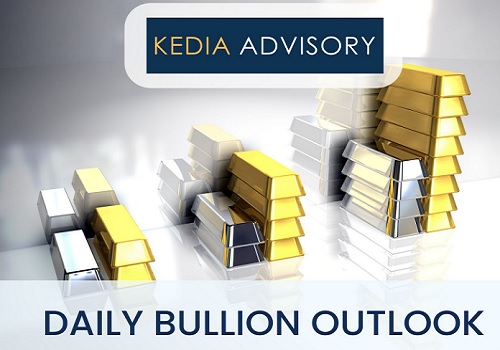Cottoncandy trading range for the day is 51950-55470 - Kedia Advisory

Gold
Gold prices surged by 1.38%, settling at 85,384, as concerns over U.S. President Donald Trump’s tariff policies fueled safe-haven demand. The proposed tariffs on Mexican, Canadian, and Chinese goods have heightened fears of retaliatory measures, adding to global trade uncertainties. Additionally, the inflationary impact of these tariffs supports gold’s appeal as a hedge against rising prices. Traders are now betting on Federal Reserve rate cuts in June and September, following data that showed inflation edged down in January as expected. In terms of physical demand, India’s gold consumption in the second half improved but remained lower than usual due to record-high prices. Indian dealers continued offering discounts, with rates ranging from $12 to $27 per ounce, compared to last week's $35. February gold imports in India are set to plunge by 85% year-on-year, reaching a 20-year low. Meanwhile, in China, gold traded at par to a $3 discount, while Singapore saw a range between a $0.50 discount and a $3 premium. Hong Kong dealers offered gold between a $1.8 discount and a $2.3 premium, whereas Japanese dealers traded it between a $6 discount and a $1.5 premium. World Gold Council forecasts India’s gold demand to moderate between 700-800 metric tons in 2025, down from last year’s 802.8 tons, with investment demand expected to remain robust. Technically, gold is in short covering, with open interest dropping by 1.05% to 13,892 contracts while prices gained 1,165 rupees. Key support is at 84,790, with a further decline possibly testing 84,190. Resistance stands at 85,710, and a break above this could push prices toward 86,030.
Trading Ideas:
* Gold trading range for the day is 84190-86030.
* Gold rose as concerns over U.S. President Donald Trump's tariff policies prompted safe-haven flows.
* Trump's proposed tariffs on Mexican and Canadian goods, set to take effect on March 4, alongside an additional 10% duty on Chinese goods.
* Fed could restart cuts to short-term borrowing rates in June and follow up with another reduction in September.
Silver
Silver prices surged by 1.83%, settling at 96,055, driven by a weaker dollar and safe-haven demand amid concerns over shifting U.S. trade policies. U.S. President Donald Trump's announcement of tariffs on Canadian, Mexican, and Chinese imports heightened fears of trade tensions, prompting Beijing to consider countermeasures. Additionally, supply and demand uncertainties continue to influence market sentiment. While Hecla Mining reported a 13% increase in silver output to 16.2 million ounces in 2024, U.S. silver coin purchases declined by 27% year-over-year in January, marking the lowest January demand since 2018. Traders are maintaining bets that the Federal Reserve will begin cutting interest rates in June, with a second cut likely in September, following inflation data that met expectations. Industrial silver demand is forecast to reach a record high, surpassing 700 million ounces, driven by structural gains in green economy applications. Meanwhile, physical investment is expected to rise by 3%, while jewelry demand could decline by 6%, led by weaker demand in India due to high local prices. From a technical perspective, silver is experiencing short covering, with open interest falling by 3.2% to 19,172 contracts while prices climbed 1,727 rupees. Key support is at 94,900, with further downside potential towards 93,750. Resistance is now seen at 96,825, and a break above this level could push prices towards 97,600. Market participants will closely monitor trade developments and monetary policy cues for further direction.
Trading Ideas:
* Silver trading range for the day is 93750-97600.
* Silver rose driven by a weaker dollar and safe-haven buying amid concerns over shifting US trade policy.
* UBS forecasts silver to hit $38 per ounce within 12 months
* US silver coin purchases falling 27% year-over-year in January to 3.5 moz, the lowest January demand since 2018.
Crude oil
Crude oil prices declined by 2.11%, settling at 5,989, as concerns over global economic growth and oil demand weighed on sentiment. Although China’s manufacturing activity rose to a three-month high in February, raising hopes for stronger fuel demand, broader uncertainties surrounding trade policies and geopolitical tensions kept gains in check. The ongoing friction between Ukrainian President Volodymyr Zelenskyy and former U.S. President Donald Trump has added uncertainty regarding a Russia-Ukraine peace deal, increasing the likelihood that sanctions on Russia’s oil sector will persist, which could further strain global supply. On the supply front, Kazakhstan’s crude oil and gas condensate production surged by 13% in February to a record 2.12 million barrels per day (bpd), once again exceeding its OPEC+ quota of 1.468 million bpd. Meanwhile, U.S. crude oil inventories fell by 2.332 million barrels for the week ending February 21, contrary to expectations of a 2.54 million barrel build. However, crude stocks at the Cushing delivery hub rose by 1.282 million barrels, while distillate stockpiles surged by 3.908 million barrels, the highest in seven weeks. From a technical perspective, crude oil is experiencing fresh selling, with open interest surging by 56.35% to 5,194 contracts while prices dropped by 129 rupees. Key support is at 5,904, with a break below potentially testing 5,818. Resistance is seen at 6,112, and a move above this level could push prices towards 6,234.
Trading Ideas:
* Crudeoil trading range for the day is 5818-6234.
* Crude oil settled lower as worries about growth and uncertainty about the outlook for oil demand weighed.
* Kazakhstan hikes oil output to a record high of 2.12 mln bpd in February
* Money managers cut their net long U.S. crude futures and options positions, the U.S. CFTC said.
Natural gas
Natural gas prices surged by 4.78%, settling at 355, driven by strong LNG export demand and near-record output levels. Despite this price increase, forecasts indicate milder weather and reduced heating demand in the coming weeks, which could slow withdrawals from storage. U.S. gas production in the Lower 48 states rose to 104.7 billion cubic feet per day (bcfd) in February, recovering from weather-related disruptions in January when freeze-offs impacted supply. Looking ahead, meteorologists project that temperatures will remain warmer than average through mid-March. Consequently, gas demand, including exports, is expected to decline from 125.7 bcfd this week to 117.7 bcfd next week and further down to 114.0 bcfd in two weeks. U.S. utilities withdrew 261 billion cubic feet (bcf) of natural gas from storage for the week ending February 21, aligning closely with expectations of 256 bcf. Storage levels now stand at 1,840 bcf, 23.4% lower than last year and 11.5% below the five-year average, reinforcing supply concerns. The U.S. Energy Information Administration (EIA) forecasts record natural gas production and demand in 2025. Dry gas output is expected to rise from 103.1 bcfd in 2024 to 104.6 bcfd in 2025, while consumption will increase to 90.7 bcfd. LNG exports are projected to grow to 14.0 bcfd in 2025 and 16.2 bcfd in 2026. Technically, natural gas is experiencing fresh buying, with open interest rising by 15.95% to 16,933 contracts. Key support is at 333.7, with a break below potentially testing 312.4. Resistance is at 371, and a move above could push prices towards 387.
Trading Ideas:
* Naturalgas trading range for the day is 312.4-387.
* Natural gas jumped with flows to LNG export plants near record highs.
* Storage levels remain about 12% below the five-year average due to earlier extreme cold.
* Increased flows to Venture Global’s Plaquemines LNG plant, which reached 1.8 bcfd last week, contributed to the rise.
Copper
Copper prices rose by 0.52%, settling at 866.05, as markets reacted to potential new U.S. tariffs on copper imports under President Trump’s trade policies. The announcement of an investigation into import duties sparked concerns over domestic supply constraints, given that the U.S. relies on imports for nearly half of its copper consumption. With only two major smelters operating domestically, any new tariffs could disrupt supply chains and push prices higher. In China, copper supply remains ample, with treatment charges for smelters staying negative, indicating overcapacity in refined production. Copper inventories have surged toward the 270,000-tonne mark, tripling since the beginning of the year. Meanwhile, Chile, the world’s largest copper producer, saw a 2.1% year-on-year decline in output in January, producing 426,889 metric tons. On the global front, the refined copper market recorded a 22,000-ton deficit in December, narrowing from November’s 124,000-ton shortfall, according to the International Copper Study Group (ICSG). However, for the full year, the market swung to a surplus of 301,000 metric tons from a 52,000-ton deficit in the previous year. China’s refined copper production in December increased by 4.3% year-on-year to 1.24 million metric tons, with daily output averaging 40,000 tons. Technically, copper is under fresh buying momentum, with open interest rising by 4.16% to 6,407 contracts. Immediate support is at 861.3, with a break below potentially testing 856.5. Resistance is at 869.8, and a move above this level could push prices toward 873.5.
Trading Ideas:
* Copper trading range for the day is 856.5-873.5.
* Copper gained as markets continued to assess the impact that tariffs by US President would have on domestic capacity.
* Treatment charges for Chinese smelters were still below zero, reflecting the large extent of overcapacity in refined copper production.
* Copper stocks in China rose toward 270,000 tonne mark, thrice the level from the start of the year.
Zinc
Zinc prices rose by 1.26% to settle at 270.05, supported by a weaker dollar and expectations of fiscal stimulus from China, the world’s largest consumer. China's manufacturing PMI returned to expansion in February, reaching 50.2 from 49.1 in January, signaling improved industrial activity. The People's Bank of China (PBoC) has also hinted at adjusting policies to bolster economic growth amid external challenges and weak domestic demand. The upcoming National People's Congress (NPC) meeting on March 5 is expected to provide further insights into potential stimulus measures. On the supply side, global mined zinc production declined for the third consecutive year in 2024, mainly due to lower output in China, Canada, South Africa, and Peru. The world's largest zinc mine, Red Dog in Alaska, is set to slow production in 2025 as ore reserves near depletion. As a result, the global zinc market shifted to a deficit of 62,000 metric tons in 2024, reversing a surplus of 310,000 tons the previous year, according to ILZSG. Refined zinc metal demand remained stable at 13.6 million tons, with declining consumption in China, Europe, and the U.S. offset by increased demand from Brazil, India, and South Korea. Technically, the market is experiencing short covering, with open interest falling by 0.85% to 2,335 contracts. Zinc has immediate support at 267.8, with further downside potential to 265.5. On the upside, resistance is at 271.5, and a break above this level could drive prices toward 272.9.
Trading Ideas:
* Zinc trading range for the day is 265.5-272.9.
* Zinc gains on hopes that China would announce a fiscal stimulus package that would boost metals demand.
* China's manufacturing activity returned to expansion in February.
* Spotlight will be on China's National People's Congress meeting scheduled for March 5 to see if the country unveils more stimulus.
Aluminium
Aluminium prices gained 0.51% to settle at 258.55, driven by the European Union's agreement to ban Russian primary aluminium imports as part of fresh sanctions. This move added supply concerns, pushing U.S. aluminium premiums up by 25% since February 7 and 60% since Trump's re-election in November 2024. Meanwhile, global aluminium production rose 2.7% year-on-year in January, reaching 6.252 million tonnes, according to the International Aluminium Institute (IAI). China's aluminium output hit a record 44 million tonnes in 2024, though production is expected to slow due to Beijing's 25-million-tonne cap imposed since 2017 to curb oversupply and emissions. Despite bullish factors, concerns over a trade war weighed on gains. The U.S. imposed a 10% tariff on Chinese imports on February 4, with an additional 10% duty expected soon. Trump also confirmed a 25% tariff on Mexican and Canadian goods, which could slow global economic growth and weaken demand. Additionally, post-holiday inventory buildup in China is putting pressure on prices, with domestic operating capacity gradually increasing in February. Chinese aluminium exports rose 17% in the first ten months of the year, reaching 5.5 million tonnes, while December’s production climbed 4.2% year-on-year to 3.77 million tonnes. Technically, the market remains in fresh buying, with open interest increasing by 6.03% to 3,254 contracts. Aluminium has immediate support at 257.7, with further downside potential at 256.6. Resistance is at 259.4, and a breakout above this level could push prices toward 260.
Trading Ideas:
* Aluminium trading range for the day is 256.6-260.
* Aluminium gains as EU envoys' agreement to ban Russian primary aluminium imports in a fresh sanctions package.
* Global primary aluminium output in January rose 2.7% year on year to 6.252 million tonnes – IAI
* China produced 44 million tons of aluminum in 2024, the most on record.
CottonCandy
CottonCandy prices edged up by 0.49% to settle at 53,390, supported by the Cotton Corporation of India’s (CCI) plan to procure over 100 lakh bales at the Minimum Support Price (MSP). However, the overall cotton output for the 2024-25 season is expected to decline to 301.75 lakh bales due to lower yields in Gujarat and northern regions, compared to 327.45 lakh bales in the previous season. The total cotton supply until January 2025 stood at 234.26 lakh bales, consisting of fresh pressings (188.07 lakh bales), imports (16 lakh bales), and an opening stock of 30.19 lakh bales. Despite this, price gains remain limited due to increased supply and subdued mill demand, as mills remain well-stocked. India’s domestic cotton consumption is projected at 315 lakh bales, while exports are estimated to decline to 17 lakh bales from 28.36 lakh bales in the 2023-24 season. Global supply remains strong, with Brazil’s cotton production projected to rise by 1.6% to 3.76 million tons, and its planting area expanding by 4.8%. Meanwhile, the U.S. cotton balance sheet saw minimal changes, with domestic mill use reduced by 100,000 bales and ending stocks increased by the same amount, leading to a 39% stocks-to-use ratio. In Rajkot, a key spot market, prices dropped by 0.38% to 25,357.2 rupees. Technically, the market is under short covering, with open interest declining by 0.79% to 251. Immediate support is at 52,670, with further downside potential to 51,950 if breached. Resistance is seen at 54,430, and a breakout could push prices toward 55,470.
Trading Ideas:
* Cottoncandy trading range for the day is 51950-55470.
* Cotton gains as CCI is likely to buy more than 100 lakh bales of cotton at MSP during the current cotton year.
* CAI the overall cotton output is estimated to dip to 301.75 lakh bales due to lower yield in Gujarat and the northern region.
* Brazil’s 2024-25 cotton production is projected to be 1.6 per cent higher at 3.7616 million tons
* In Rajkot, a major spot market, the price ended at 25357.2 Rupees dropped by -0.38 percent.
Turmeric
Turmeric prices declined by 1.27% to settle at 12,292 as the arrival of new crops commenced in major markets. The turmeric cultivation area increased by 10% to 3.30 lakh hectares compared to the previous season. However, untimely rains are expected to cap productivity gains, limiting overall production growth. Last year, total production stood at 10.75 lakh tonnes, but a 10-15% decline in productivity is anticipated in key growing areas like Nanded due to smaller rhizomes and crop rot issues. As harvesting picks up, further clarity on production losses will emerge. Despite production concerns, price declines were restrained due to slow rhizome growth and lower yield estimates. Additionally, turmeric exports from April to November 2024 increased by 9.8% to 121,601.21 tonnes, compared to 110,745.34 tonnes in the same period in 2023. In November 2024, exports reached 12,721.25 tonnes, marking a 48.22% jump from November 2023. However, compared to October 2024, exports fell by 20.18%. On the import side, turmeric imports surged by 101.80% in the April-November period, totaling 18,937.95 tonnes, driven by rising domestic demand. However, monthly imports dropped 34.84% from October to November 2024. In the Nizamabad spot market, turmeric prices declined by 1.57% to 12,648.75 rupees. Technically, the market witnessed fresh selling with open interest marginally rising by 0.04% to 12,700. Turmeric has immediate support at 12,224, with further downside potential to 12,156. On the upside, resistance is seen at 12,398, and a breakout could push prices towards 12,504.
Trading Ideas:
* Turmeric trading range for the day is 12156-12504.
* Turmeric prices dropped as arrival of new turmeric crop has started.
* New turmeric crop is arriving in Nizamabad and Hingoli Mandi.
* However downside seen limited as new crop yields are expected to be 10-15% lower this year.
* In Nizamabad, a major spot market, the price ended at 12648.75 Rupees dropped by -1.57 percent.
Jeera
Jeera prices declined by 0.89% to settle at 21,145 due to sluggish demand, with the current export business being fulfilled from existing stocks. Farmers still hold around 20 lakh bags of cumin, with only 3-4 lakh bags expected to be traded by the end of the season, leaving a significant carry-forward stock of 16 lakh bags. Production for the current season is expected to remain similar to last year due to improved crop conditions and favorable sowing. However, the start of the new crop in Gujarat has been delayed by nearly a month due to unfavorable weather, limiting the downside. India’s cumin seed production for 2023-24 increased to 8.6 lakh tonnes from an area of 11.87 lakh hectares, compared to 5.77 lakh tonnes from 9.37 lakh hectares the previous year, according to Spices Board data. Indian cumin remains the cheapest globally, priced at $3,050 per tonne, making it an attractive option for international buyers, including China, where cumin is priced $200-$250 higher. Despite geopolitical tensions in the Middle East, strong domestic and international demand, particularly from Europe, has boosted cumin exports. Between April and November 2024, exports surged by 74.04% to 147,006.20 tonnes, compared to 84,467.16 tonnes in the same period of 2023. Technically, the market saw fresh selling with open interest rising by 0.12% to 2,532. Jeera has immediate support at 20,980, with further downside potential to 20,800. On the upside, resistance is seen at 21,310, and a breakout could push prices towards 21,460.
Trading Ideas:
* Jeera trading range for the day is 20800-21460.
* Jeera dropped as demand is low and the current export business is being met from the available stock.
* The current season is expected to have similar production levels as last year due to better crop conditions.
* However downside seen limited as the start of the new crop of cumin in Gujarat has been delayed by about a month.
* In Unjha, a major spot market, the price ended at 21094.85 Rupees gained by 0.02 percent..
Views express by all participants are for information & academic purpose only. Kindly read disclaimer before referring below views


















